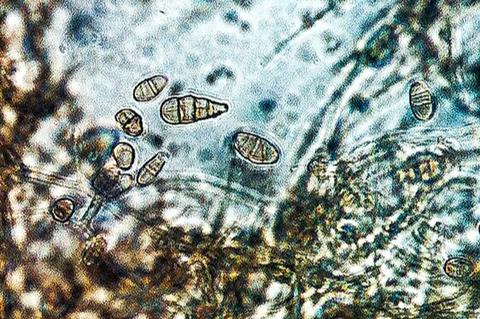In ecosystems around the world, fungi play crucial roles in supporting plant life.
Their ability to form connections between plant roots can enhance water and nutrient uptake and promote plant growth. While fungal symbioses have been extensively explored in the past, some researchers believe these underground networks may be far more complex than they seem.

Most studies on plant-fungal interactions focus on mycorrhizal fungi, which are famous for constructing nutrient-sharing pathways. However, a new experiment designed by NAU scientists suggests an often-overlooked fungal group—dark septate endophytes (DSEs)—may be capable of something similar to their more popular counterparts: linking the roots of neighboring plants to facilitate water sharing and boost their host’s biomass. DSEs may even be responsible for keeping plant networks alive in some of the Southwest’s most drought-prone areas.
READ MORE: How plants build the microbiome they need to survive in a tough environment
READ MORE: Hidden fungal allies strengthen defenses of black poplars and influence insect interactions
The study, published in the journal Communications Biology, features co-authors Beatrice Bock, a doctoral student studying biology at NAU; Nancy Johnson, a Regents’ professor in the School of Earth and Sustainability; and Catherine Gehring, a Regents’ professor in the Department of Biological Sciences.
Underground secrets
“Mycorrhizal fungi have gotten a lot of attention because they form really well-known partnerships with plants,” Bock said. “Some also make mushrooms, which are the showy side of fungi and tend to capture people’s interest more than the fungi we can only see under a microscope or with DNA sequencing. But if DSEs are also present, that changes the picture of what is happening underground. What else is going on in the soil that we’ve been missing?”
To answer that question, Bock and her colleagues designed an experiment using pairs of plants in controlled laboratory environments. Separated by a 3-millimeter air gap that blocked direct soil contact, one plant in each duo was inoculated with a DSE fungus.
Researchers found the fungus could use thin, threadlike structures called hyphae to reach across the air gap and create a living bridge between the plants’ roots. In plant pairs containing the DSE fungus, water from the host plant marked with dye was later detected in the receiver plant’s leaves, indicating the hyphae successfully transferred water between the specimens.
Plants with access to a fungal network also grew more than two times larger than those in control groups without the fungus.
Extreme environments
DSEs have been detected in thousands of plant species worldwide and are common in extreme environments like those experiencing drought. While their function is still debated, Bock said these results point to DSEs being key fungal players in keeping plants alive in challenging conditions, such as in the Southwest.
“These fungi are already believed to support plant health in drought-prone areas like much of Arizona, and our results provide more evidence that they could help plants survive and thrive under water-limited conditions,” Bock said.
NAU’s study was the first controlled demonstration that DSEs can form shared root networks between multiple plants. Bock hopes its findings will encourage others to dig deeper into how these fungi influence plant interactions and ecosystem dynamics.
“This study has solidified my interest in the bigger picture of how and why plants and fungi form symbiotic relationships,” Bock said. “I’m graduating in the spring, and as I think about what’s next, I keep coming back to these questions. There’s still so much we don’t know, and I’m excited to keep exploring the hidden world of fungi and plant relationships.”







No comments yet